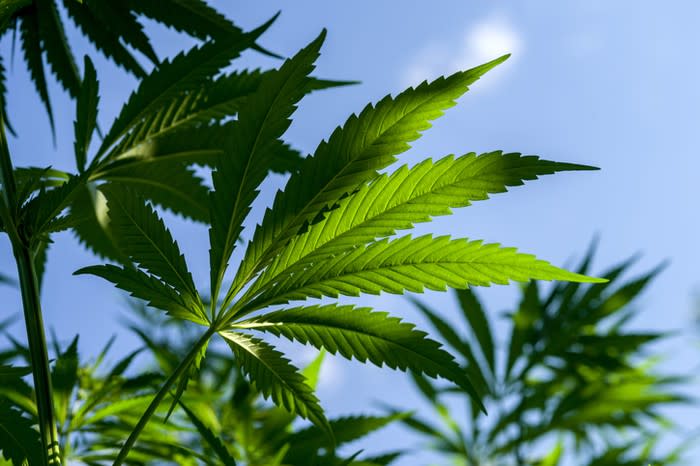Canopy Growth's Poor Earnings Report: All the Key Metrics You Should Know
Canopy Growth (NYSE: CGC), a leading Canadian cannabis grower, reported fiscal first-quarter 2020 results for the period ended June 30 after the market closed on Wednesday.
Shares of the largest cannabis stock by market cap plunged 11.7% in after-hours trading on Wednesday. We can attribute the market's ire to the company posting a much larger loss and lighter revenue than Wall Street was expecting.
Here's how the quarter worked out for Canopy and its investors.

Canopy Growth's results: The key numbers
All amounts are in Canadian dollars; CA$1 = $0.75.
Metric | Fiscal Q1 2020 | Fiscal Q1 2019 | Change |
|---|---|---|---|
Net revenue | CA$90.5 million | CA$25.9 million | 249% |
Operating income (loss) | (CA$123.1 million) | (CA$30.7 million) | Loss widened by 301% |
Net income | (CA$1.28 billion) | (CA$91.0 million) | Loss widened by 1,308% |
Earnings per share | (CA$3.70) | (CA$0.40) | Loss widened by 825% |
Data source: Canopy Growth. Results based on International Financial Reporting Standards (IFRS).
Revenue edged down nearly 4% from last quarter, with the culprit being a big sequential decline in sales of oil and softgel capsules in the Canadian recreational market, as we'll get to in a moment.
Canopy's bottom line was hurt badly by the company taking a non-cash charge of $1.2 billion Canadian dollars ($904 million) "on the extinguishment of warrants held by Constellation Brands upon the amendment of the Investor Rights Agreement between Canopy Growth and Constellation," according to the earnings release. The charge wasn't a surprise, as last quarter, the company said that it would probably take a "material" charge in Q1 related to its pending acquisition of Acreage Holdings, a U.S.-based cannabis operator. That said, the size of the charge likely caught many investors off guard.
Wall Street was modeling for a quarterly loss of CA$0.37 per share on revenue of CA$107.1 million, so both results fell woefully short of estimates.
Gross margin before the IFRS fair-value impacts was 15% of net revenue, down from 43% in the year-ago period and a bit lower than last quarter's 16%. The decline was primarily for the same reason as last quarter's big year-over-year drop: Canopy is investing in facilities that are not yet producing or that had underutilized capacity. Moreover, there was also a shift in product mix away from higher-margin products (oils and softgels) due to inventories evening out.
At the end of the quarter, Canopy had CA$3.1 billion in cash and cash equivalents. While that's down from CA$4.5 billion in the year-ago period, it's still the biggest cash position among the cannabis growers, thanks to the company's partnership with alcoholic-beverage giant Constellation Brands (NYSE: STZ), which owns a 38% stake in Canopy.
Product results
Category | Gross Revenue Fiscal Q1 2020 | Gross Revenue Fiscal Q1 2019 | Change (Decline) |
|---|---|---|---|
Canadian recreational cannabis, business to business | CA$50.4 million | -- | N/A |
Canadian recreational cannabis, business to consumer | CA$10.6 million | -- | N/A |
Canadian recreational cannabis total | CA$61.0 million | -- | N/A |
Canadian medical cannabis | CA$13.1 million | CA$21.3 million | (38%) |
Canadian cannabis sales total | CA$74.1 million | CA$21.3 million | 248% |
International medical cannabis | CA$10.5 million | CA$3.4 million | 209% |
Cannabis sales total | CA$84.6 million | CA$24.7 million | 243% |
Other revenue (vaporizers, extraction services, clinic partners, and merchandise) | CA$18.8 million | CA$1.2 million | 1,467% |
Total gross revenue | CA$103.4 million | CA$25.9 million | 299% |
(Less excise tax) | (CA$12.9 million) | -- | -- |
Net revenue | CA$90.5 million | CA$25.9 million | 249% |
Data source: Canopy Growth.
Breaking out revenue a few other ways:
Total gross cannabis revenue was comprised of 72% recreational sales and 28% medical sales.
International revenue made up about 12% of total gross marijuana sales, up significantly from about 2% last quarter.
Total gross cannabis sales accounted for about 82% of the company's total revenue, while "other revenue" contributed the remaining 18%.
Of the CA$84.6 million in total gross cannabis sales, the breakdown by product form was CA$68.0 million (80%) in dry cannabis and CA$16.6 million (20%) in oils and softgels. The oil and softgel percentage is down significantly from last quarter's 40%. Since these are valued-added products, the decline hurt the bottom line.

Recreational cannabis sales
Here's how the CA$61.0 million in gross recreational sales broke out by product form:
Dry cannabis: CA$60.8 million
Oils and softgels: CA$200,000
In Q1, recreational sales had no basis for comparison with the year-ago period because adult-use marijuana has only been legal in Canada since October 2018. Sales, however, fell 11% from the fourth quarter of fiscal 2019. Dry cannabis sales jumped 94% from last quarter, but revenue from oils and softgels dropped more than CA$36 million. In the earnings release, Canopy explained a part of this huge sequential decline in oils and softgels:
During Q1 2020, we evaluated the ... estimated on-hand provincial and territorial inventory levels against the recent demand and sales trends ... to ensure we make adjustments to our supply chain based on the purchasing preferences of recreational consumers. As a result of this evaluation, we believe that the risk of an over-supply of certain oil and softgel formats may exist in certain markets due, in part, to incomplete retail platforms in most provinces. Based on this assessment, we have estimated variable consideration that may result from rights of return in the amount of $8 million in gross revenue, which corresponds to estimated future returns of $6.4 million, net of excise tax, and the estimated return amount has been reflected in net revenue.
Canadian medical cannabis sales
While Canadian medical sales fell year over year, they were up 15% from last quarter's CA$11.6 million, so they're moving in the right direction. As Canopy explained in last quarter's earnings release, the recent year-over-year declines in this category have largely been due to the "major transformation" of its Canadian online medical store and supply constraints, which have since been remedied.
For total medical cannabis sales (Canada plus international), the breakout by product form was 70% oils and softgels and 30% dried cannabis.
International medical cannabis sales
This category was a bright spot. Sales not only tripled from the year-ago period, but they posted a nearly sixfold increase from last quarter's meager CA$1.8 million.
Last quarter's poor showing was primarily due to supply constraints, with management noting on the earnings call that "this issue should soon be behind the company, given its Canadian medical channel is fully supplied and its Danish production capacity is due to come on line this calendar year." Indeed, it looks like Canopy's international medical cannabis business is back on the growth track.
Key operational stats
Canopy sold 10,549 kilograms and kilogram equivalents of cannabis in the quarter, up 13% from last quarter (1 kilogram equals about 2.2 pounds).
The company harvested 40,960 kilos, up 323% from the year-ago period's 9,685 kilo, and up considerably from last quarter's 14,469 kilos. The harvest was bigger than the 34,000 kilos that management had projected and bodes well for sales in future quarters.
Major news after the quarter ended
Soon after the quarter ended, on July 2, Canopy announced the departure of founder and co-CEO Bruce Linton. It's widely speculated that Linton was terminated because Constellation Brands' top management wasn't pleased with Canopy's fiscal Q4 2019 results. At that time, Mark Zekulin was appointed as sole CEO, but only temporarily. The company is searching for a permanent CEO.
In addition, on Aug. 9, Canopy announced that it had entered into an agreement to acquire all of the remaining unowned shares in Beckley Canopy Therapeutics, a global cannabinoid-based medical researcher.
Looking ahead: New revenue streams on target to come on line in fiscal 2020
Canopy is investing heavily in initiatives aimed at fueling long-term growth and capturing sizable market share in the burgeoning regulated cannabis market. So, a widening loss was expected, though it was bigger than most investors were likely expecting. Moreover, the decline in revenue from last quarter is somewhat concerning.
That said, it's early in the game, and the company is on track to have two new categories of revenue sources beginning this fiscal year:
Cannabis derivatives in Canada: Edibles, vapes, cannabis-infused beverages, and other value-added products will become legal in Canada in October. Canopy plans to roll out a portfolio of these products, including beverages that it's developing with partner Constellation Brands.
Hemp-derived cannabidiol (CBD) products in the United States: The company said in the earnings release that it's "developed a broad CBD product offering that includes skincare and cosmetics, topical creams, vape products, beverages, edibles, oils and softgels." CBD is a nonpsychoactive chemical that's been linked to various medicinal benefits.
Beth McKenna owns shares of Canopy Growth. The Motley Fool recommends Constellation Brands. The Motley Fool has a disclosure policy.
This article was originally published on Fool.com

 Yahoo Finance
Yahoo Finance 